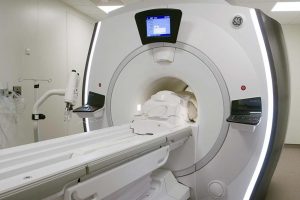Recently, oncologists have been increasingly using drugs that destroy tumor cells, delivering a targeted dose of radiation to them. It is an effective and safe method of fighting cancer and has proven itself in the treatment of thyroid cancer, neuroendocrine tumors, some brain tumors (so-called meningeomas) and prostate cancer. Such treatment with the use of drugs labeled with the isotope lutetium-177 is currently possible abroad, since they are not yet certified in Russia.
Oncology is one of the fastest growing areas of medicine. In recent years, approaches to the treatment of malignant tumors have changed dramatically. In addition to classical chemotherapy drugs, modern doctors have at their disposal targeted drugs, various types of immunotherapy. It became possible to study tumor cells at the molecular genetic level, which helped to create new drugs and make treatment more personalized. Radiation therapy has become more targeted and safer, and operations have become less aggressive.
In this article, we will talk about two types of radionuclide therapy: peptide-receptor radionuclide therapy with Lu177-DOTATATE / DOTATOC radiopharmaceuticals and prostate cancer therapy with Lu177-PSMA radionuclide. We will look at how radionuclide therapy works, when it is used, and how safe it is.
Recently, peptide receptor radionuclide therapy (PRRT) has become widely used. It is currently used for the treatment of neuroendocrine tumors, as well as for the treatment of tumors of the meninges (meningeomas).
PRRT is often the last resort for cancer patients with advanced, metastatic, inoperable tumors that cannot be treated with other treatments.
Radioactive sniper rifle
Classic cancer treatments such as chemotherapy and radiation therapy can be compared to carpet bombing. The essence of the action of chemotherapy drugs and ionizing radiation is that they damage rapidly multiplying cells. First of all, of course, we are talking about tumor cells. But along the way, normal cells also come under attack, hence numerous side effects arise.
Modern doctors and scientists are interested in maximally selective, targeted action on tumor cells without harming the patient’s health. And today such opportunities exist. For example, targeted drugs work like sniper rifles, they attack certain substances that a malignant tumor needs to survive, grow uncontrollably, and defend against the immune system. Modern technologies make it possible to carry out radiation therapy in such a way that the irradiation area matches the contours of the tumor as closely as possible and does not affect the surrounding tissues. There is brachytherapy – when a miniature radiation source in the form of granules is placed directly into or near a tumor.
Such a long introduction with the mention of targeted therapy and radiation therapy is not accidental here. Because PRRT is, to some extent, a combination of the two. The drug molecule consists of two parts:
The transport part is a protein molecule that recognizes a specific receptor protein on the surface of a tumor cell and interacts with it.
The radioactive substance is attached to the transport protein, with the help of it it is precisely delivered to the tumor cells and destroys them.
Various substances can be used as carrier proteins and radioactive agents. Neuroendocrine tumors often contain many receptors for somatostatin, a hormone produced in the hypothalamus of the brain. In such cases, somatostatin analogs are used for PRRT: octreotide (DOTATOC) and octreotide (DOTATATE). The lutetium isotope Lu-177 is often used as a radioactive substance. It destroys tumor cells using beta radiation. Due to the fact that it does not penetrate deeply into the tissues, only the tumor receives a lethal dose, and the surrounding healthy tissues remain intact. Some compounds use the yttrium isotope Y-90.
These radiopharmaceuticals labeled with lutetium-177 are currently used for neuroendocrine tumors that can occur in the stomach, rectum, pancreas, small and large intestine, adrenal glands and thyroid gland. It is increasingly used for tumors of the meninges – meningiomas.
Another striking example of radionuclide therapy is the use of Lu177-PSMA in prostate cancer. The same isotope of lutetium acts here as a therapeutic agent, and its targeted delivery is provided by a protein that binds to the prostate specific membrane antigen (in English – prostate specific membrane antigen, abbreviated PSMA), which are found in large quantities on the surface of cancer cells.
What malignant tumors can be treated with lutetium-177?
The main condition that makes PRRT possible is the presence of a molecular target. The corresponding proteins must be present on the surface of tumor cells – the somatostatin receptor or PSMA. This can be checked with scintigraphy or PET-CT. The essence of both methods is that a substance is injected into the body that binds to the receptor and “highlights” the tumor cells in the images taken with the help of special devices. If the tumor foci “glow”, then they have the desired receptor, and PRRT will be effective.
A patient is considered a suitable candidate for this type of treatment in the following cases:
If the tumor is in an advanced stage, there are metastases.
If other treatments fail, the tumor will progress despite therapy. For example, Lu177-PSMA is used in cancer that is resistant to hormones and chemotherapy.
If the tumor cannot be removed surgically.
How is the treatment carried out?
Medicines for PRRT are available in solutions and administered intravenously through a drip for 10–20 minutes. After that, the doctor must monitor the patient’s condition for at least 48 hours. Usually, for each injection of the drug, the patient is hospitalized in the clinic for 4–5 days. A total of 3 to 5 treatment cycles are needed at intervals of 8 weeks. The effectiveness of the drug is checked using scintigraphy and layer-by-layer scanning combined with computed tomography (SPECT-CT). During the course of treatment, blood tests are performed, kidney and liver function is monitored.
How safe is it?
There are no absolutely safe drugs. Any medication has its own side effects. For example, there is a huge list of possible adverse reactions to chemotherapy, and some of them are quite serious. Patients generally tolerate PRRT well. Some people are worried about nausea and vomiting, dry mouth. Sometimes the number of leukocytes and platelets in the blood decreases – but usually only slightly. In very rare cases, the drugs have a toxic effect on the kidneys and cause a blood disorder called myelodysplastic syndrome.
In general, the risks are very small – due to the fact that drugs for PRRT act as targeted, like snipers.
Perspectives
Neuroendocrine tumors are a special group of oncological diseases. They progress slowly. Even if such a tumor is diagnosed in an advanced stage, the patient can live for quite a long time. Therefore, we need effective and safe drugs that can be used for a long time. PRRT is often the optimal treatment.
Modern scientists are looking for new possibilities of using PRRT. Currently studying:
combining PRRT with other anticancer drugs;
refresher courses PRRT https://en.wikipedia.org/wiki/Peptide_receptor_radionuclide_therapy;
combinations of different radiopharmaceuticals, different transport proteins and isotopes;
expansion of the list of indications, application of the method for pheochromocytomas, paragangliomas and other tumors;
the introduction of drugs into the arteries feeding the tumors – in such cases, they do not enter the general bloodstream at all, you can increase the dose without fear of serious side effects.
